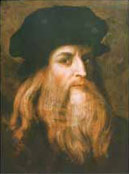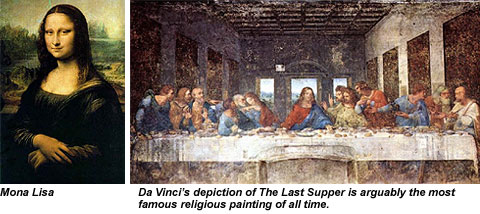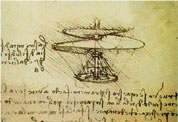 Leonardo da Vinci, (April 15, 1452 – May 2, 1519) was a Florentine artist, one of the great masters of the High Renaissance. He was also known as a scientist, mathematician, engineer, inventor, anatomist, painter, sculptor, architect, botanist, musician and writer. His profound love of knowledge and research was the keynote of both his artistic and scientific endeavors. His innovations in the field of painting influenced the course of Italian art for more than a century after his death, and his scientific studies-particularly in the fields of anatomy, optics, and hydraulics-anticipated many of the developments of modern science.
Leonardo da Vinci, (April 15, 1452 – May 2, 1519) was a Florentine artist, one of the great masters of the High Renaissance. He was also known as a scientist, mathematician, engineer, inventor, anatomist, painter, sculptor, architect, botanist, musician and writer. His profound love of knowledge and research was the keynote of both his artistic and scientific endeavors. His innovations in the field of painting influenced the course of Italian art for more than a century after his death, and his scientific studies-particularly in the fields of anatomy, optics, and hydraulics-anticipated many of the developments of modern science.
Leonardo first received formal training in the area of human anatomy with an apprenticeship to Andrea del Verrocchio. He quickly mastered the subject and as a successful artist was given permission to dissect human corpses. He also studied, dissected, and illustrated animal anatomy.
It is primarily as a painter that Leonardo was and is renowned. Two of his works, the ‘Mona Lisa’ and ‘The Last Supper’, occupy unique positions as the most famous, most reproduced and most parodied portrait and religious painting of all time.
As an engineer, Leonardo’s ideas were vastly ahead of his time. He conceptualized a helicopter, a tank, concentrated solar power, a calculator, the double hull and outlined a rudimentary theory of plate tectonics. Relatively few of his designs were constructed or were even feasible during his lifetime, but some of his smaller inventions, such as an automated bobbin winder and a machine for testing the tensile strength of wire, entered the world of manufacturing unheralded. As a scientist, he greatly advanced the state of knowledge in the fields of anatomy, civil engineering, optics, and hydrodynamics.

The life and work of the great Italian Renaissance artist and scientist Leonardo da Vinci have proved endlessly fascinating for later generations. What most impresses people today, perhaps, is the immense scope of his achievement. In the past, however, he was admired chiefly for his art and art theory. Leonardo’s equally impressive contribution to science is a modern rediscovery, having been preserved in a vast quantity of notes that became widely known only in the 20th century.
 Leonardo’s observations and experiments into the workings of nature include the stratification of rocks, the flow of water, the growth of plants, and the action of light. The mechanical devices that he sketched and described were also concerned with the transmission of energy. Leonardo’s solitary investigations took him from surface to structure, from catching the exact appearance of things in nature to visually analyzing how they function.
Leonardo’s observations and experiments into the workings of nature include the stratification of rocks, the flow of water, the growth of plants, and the action of light. The mechanical devices that he sketched and described were also concerned with the transmission of energy. Leonardo’s solitary investigations took him from surface to structure, from catching the exact appearance of things in nature to visually analyzing how they function.
Leonardo’s art and science are not separate, then, as was once believed, but belong to the same lifelong pursuit of knowledge. His paintings, drawings, and manuscripts show that he was the foremost creative mind of his time.










